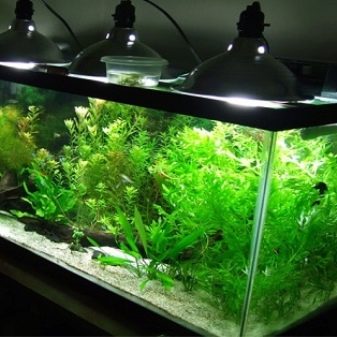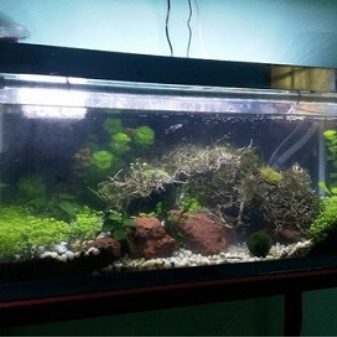Aquarium lighting with LED floodlights

Both children and adults love bright and beautiful aquarium fish, which is why you can often see an aquarium in an apartment or house. To ensure a comfortable habitat for plants and the fish themselves, it is necessary not only to regularly clean the water and feed the aquatic inhabitants, but also to provide them with the optimal amount of light. The presence of a wide variety of types of lighting allows you to choose the optimal devices that will be able to illuminate an aquarium of any size.


Advantages and disadvantages
Today, there are several options for lamps with which you can illuminate aquariums:
- luminescent (+ high recoil);
- halogen;
- incandescent lamps;
- metal halide;
- light-emitting diode (LED).
Each of the types has its own characteristics, different lighting intensity, color spectrum and power, therefore it is important to understand the characteristics in order to buy the right equipment for illuminating the aquarium. In addition, you need to decide on the type of lighting device, it can be:
- lamp: suitable for any aquarium;
- spotlight: needed for overall containers;
- tape and module: optimal for small tanks (there are also variations for large aquariums).



Each of the types of lighting has its own advantages and disadvantages, but the LED option is considered the most optimal at the moment. The advantages of this type include the following.
- Profitability. Bulbs consume a minimum amount of electricity, which means they will significantly save your budget.
- Durability. Due to their structural features, such lamps last much longer than their counterparts. If an incandescent lamp serves a thousand hours, then an LED lamp can work up to 50 thousand hours.
- Variability. It is possible to choose a different color spectrum that suits certain fish or plants.
- Reliability. LED lamps are resistant to mechanical stress and moisture, which is very important for placement in an aquarium.
- Security. The absence of harmful substances such as mercury makes the use of LED lamps safe.
- Luminous flux stability. LED lamps begin to work fully immediately after switching on, do not warm up, do not change the color spectrum and do not flicker, which has a positive effect on the contents of the aquarium.

Of the minuses, such moments can be distinguished.
- Price. LED lamps are more expensive than their counterparts, but they fully pay back the money spent.
- The same variability sometimes becomes a disadvantage. There are LED strips, lamps and spotlights, and you need to know exactly what to use in a particular case.
Aquarium lighting with LED floodlights allows high-quality illumination of the tank of any size. Thanks to the choice of floodlights with different wattage, it is possible to install from one to 4 or more products under the cover of the aquarium or near it. Not all inhabitants of a water tank prefer the same power and intensity of light, therefore for an aquarium with plants it will be one, and for a tank with corals it will be different.
Before installing lighting fixtures, you need to understand what type of lighting is needed for specific fish, plants and other inhabitants of the aquarium.


Choice of spotlights
When choosing an LED floodlight, you need to understand what its features are and which option is suitable for an aquarium. When illuminating plants, it is worth buying products that emit white light, while for algae, a yellow tint will be more pleasant. The color spectrum should be red, as it has a beneficial effect on plants and stimulates their growth. If there are flowering crops inside the tank, then a blue lamp should be placed in front of the tank.
To make aquatic inhabitants comfortable, it is recommended to use mixed light. To create one or another spectrum, you need to focus on the temperature of the lighting fixtures. Allocate:
- warm;
- neutral;
- cold light.


In warm and neutral light, the spectrum will be closer to red, with cold - closer to blue. There is also a diode version, in which red and blue bulbs are additionally installed.
LED bulbs are commonly used in closed aquariums and are fixed under the cover of the product. If the tank is open, then the installation of floodlights will be optimal. Depending on the size of the container, you can choose the number of lighting devices and their power. Street lights can be used as long as their illumination does not exceed the limits necessary for the normal growth and habitation of the inhabitants of the aquarium.

Searchlights can have different types of diodes:
- The COB is one large diode inside the product;
- SMD is a lot of small diodes.
There are varieties with and without a driver. The first option is considered to be of better quality, since it allows you to work from different voltages. To check how even and even the light from the spotlight will be, you need to point your phone camera at it. If there are stripes and noise on the screen, then the light is uneven, and if the image does not change significantly, then this is the best option for use in an aquarium. The tested options are the Soyuz and TDM SDO 10-2N products.


Payment
To properly illuminate the aquarium, you need to understand how much light is needed under certain conditions:
- for a tank without vegetation, 0.1-0.3 W / L is needed;
- for shade-loving plants and fish, 0.2-0.4 W / l is required;
- for a container with plants and light-loving fish, the norm will be 0.5-0.8 W / l;
- for an aquarium with dense vegetation, 0.8-1 W / L is required.
These rates are for standard lighting.The LED readings need to be divided by 7 to get the correct readings.

On the packaging of lamps and floodlights, wattage is often indicated in lumens. To find out which version of the device to buy, you need to use the table.
|
Bulb power (W) |
Luminous flux (lm) |
|
2-3 |
250 |
|
4-5 |
400 |
|
6-9 |
700 |
|
10-12 |
900 |
|
12-14 |
1200 |
|
17-20 |
1800 |
|
25-30 |
2500 |
|
30-40 |
3500 |
|
40-60 |
8000 |
|
80-120 |
12000 |
|
140-160 |
20000 |
The choice of power depends on the depth of the aquarium, the presence of plants and their number, as well as the fish that live in it.

To calculate the required amount of light, you can use the following scheme:
- the size of the aquarium;
- the type of plants in it and their number;
- power of LEDs of the lighting device with thermodynamic temperature indicators up to 8.0 thousand K;
- current 350-700 mA;
- illumination of 140-300 lm.
Thus, you can calculate the number of drivers and power supplies for 24 and 36 V.


Based on the size of the aquarium, you can choose the wattage of the lamps, guided by the table.
|
Luminous efficiency |
Tank volume (l) |
|
6-11 thousand lm |
200 |
|
4-7 thousand lm |
150 |
|
3-5 thousand lm |
120 |
|
3-4 thousand lm |
100 |
|
1-3 thousand lm |
70 |
Having correctly calculated all the factors, you can choose the most optimal type of lighting and the power of the lighting device.


How to fix?
Depending on the type of lighting, the type of attachment to the aquarium or near it is also selected. Installation of lamps that heat up during operation is carried out at a distance of 30 centimeters or more from the surface of the water so as not to heat it up. If a spotlight is installed using LED strips, then it can be done inside, under the aquarium lid.
For large tanks, a strong and rather powerful light is needed, so more than one lamp will be needed, which will need to be hung at the optimal height and in the right place. It is not very difficult to place a lighting device with your own hands, the main thing is to clearly understand how to do it. Mounting can be carried out to the wall, to the lid of the aquarium or to its walls. If desired, you can create stand-alone lighting systems that can be rearranged to illuminate certain areas of the aquarium.


Due to the fact that LEDs are not afraid of water, they can be mounted on the bottom of the tank or on the side of the glass, illuminating the bottom of the aquarium. NSThe horns are usually attached to the wall, but the flat versions can be placed under the lid as long as there is a large enough distance between it and the water. To fix the device on the wall, you will need dowels and self-tapping screws. The area in which the spotlight will be installed is marked on the wall. Further, in the appropriate places, holes are drilled into which the dowels are driven. Attaching the spotlight to its place, you can fix it with self-tapping screws.
When planning the placement of lighting fixtures, it is important to consider the location of the outlets so that they are convenient to use. If there are none nearby, you can lengthen the cord from the spotlight or use an extension carrier. Thanks to modern technology, it is possible to install various auxiliary devices that are programmed to turn on and off the light at a specific time, which greatly facilitates the care of the aquarium.










